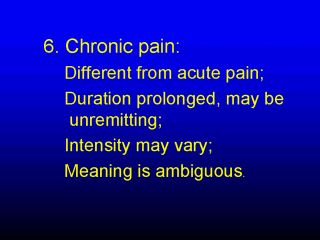| front |1 |2 |3 |4 |5 |6 |7 |8 |9 |10 |11 |12 |13 |14 |15 |16 |17 |18 |19 |20 |21 |22 |23 |24 |review |
 |
Chronic pain is increasingly
common in health care. It presents a serious management problem because people have come
to expect a life that is pain free. In other words, we have become remarkably intolerant
of any form of physical discomfort in modern life. Many hospitals now have Pain Clinics
for managing people with various chronic pain syndromes. Chronic pain is different to
acute pain. It has already been mentioned that chronic pain no longer serves a purpose of
signaling harm or damage. In addition, it often fluctuates, causing problems for people in
predicting and planning their lives. But most of all, it is ambiguous in terms of what it
means. The successful and effective management of benign chronic pain will be a major health care challenge for the 21st Century. Malignant pain remains under treated. There is no pharmacological reason for this. Cancer pain is often referred to as total pain because of its all encompassing nature and requires a multi-factorial approach to effectively manage well. There are serious deficits in pain control at all levels, from acute to malignant pain, arising from poor pain assessment, poor recording and the unwillingness to give, and receive, powerful and effective analgesia, often because of fear of addiction. While this needs to be very carefully considered in benign chronic pain, it should not be a factor inhibiting the use of, for example, opioid administration for treatment of cancer pain. Social processes are very important in both the perception and management of pain. |